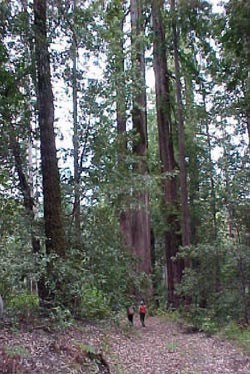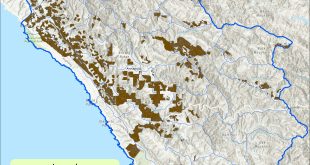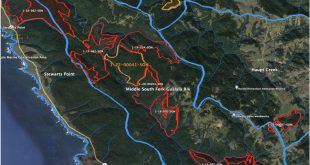The landowner submitted an application for an exemption on June 22, 2004. CDF responded the next day that they had accepted the exemption, and assigned it exemption number 1-04EX-237-SON.
Friends of the Gualala River (FoGR) is concerned that this unregulated logging activity in an old growth redwood forest — the last major stand of its type in Sonoma County — will have serious adverse environmental impacts.
Removing snags, large downed logs, and standing decadent large trees within old-growth forest is a significant adverse impact to scarce high-quality habitat for endangered northern spotted owl and marbled murrelet, and will be detrimental to the species’ recovery.
We are also concerned that using “salvage” logging and “diseased, dead and dying” exemptions to avoid the THP process will effectively enable circumvention of future regulation and provide a degraded environmental baseline by which future THPs in this old growth forest may be reviewed and authorized.
Denial of Previous Logging Plan
The Board concluded that the plan failed to conform to the California Forest Practice Rules, specifically because it failed to provide adequate information as required under 14 CCR 919.16(a), and voted 5-2 to reject the plan.
A week later the forester provided some additional information about the plan, in hopes of overturning that ruling. Agency staff reviewed the information, and determined that it was not adequate to re-open the regulatory process, which is therefore finally ended.
In September, 2003, the California Department of Forestry and Fire Protection (CDF) officially denied THP 1-00-484 SON, the plan to begin logging the Haupt Creek old growth coastal redwood forest in the northwest corner of Sonoma County.
 Old growth forest, Haupt Creek photo credit: Dave Hope, NCRWQCB |
The letter denying the plan was signed by Leslie Markham, Deputy Chief, Forest Practice, CDF. Her letter followed the final review meeting on July 31, 2003, at which the CDF official chairing the review team recommended that this plan be denied for lack of required information.
Thanks to the many people who helped protect the old growth forest by attending meetings and writing letters. Public participation can have a significant impact on the review process. |
Knowing that elected officials, members of the press and the public are paying attention to their actions can help agency staff maintain their resolve to enforce state regulations to protect the beneficial uses of resources in the public trust.
Our sincere thanks to the conscientious agency staff, who worked hard and did a thorough job in bringing important regulatory issues to the table. Thanks also to our elected representatives — Assemblymembers Berg and Wiggins and Senator Chesbro — who expressed their support and sent their staff to monitor the review process.
Summary information
The only remaining old growth coastal redwood forest in the Gualala River watershed was slated to begin falling to chainsaws. Friends of the Gualala River believes that this unique and irreplaceable forest must be protected.
Except for a few scattered trees, there is almost no old growth redwood remaining in the Gualala River watershed. In fact, there is very little in all of Sonoma County. Almost every forested acre has been cut at least once in the past 150 years.
By destroying part of the last remaining old growth habitat in the watershed, the proposed logging would threaten the survival of the local populations of birds, animals and plants dependent on old growth forest. We can’t let that happen.
THP 1-00-484 SON
The landowner, Harold Richardson, applied to CDF to log 44 acres of old growth coastal redwood forest sloping into the steep inner gorge of Haupt Creek. This land is part of the extensive holdings of the Richardson family in the area, of which about 800 acres are old growth redwood and Douglas fir forest, which have been in their family for over 100 years. The Richardsons are known in the area as good stewards of their land.
The proposed logging threatened to damage habitat for coho salmon and steelhead in Haupt Creek. It would have begun logging of the last remaining major stand of old growth coastal redwood forest in Sonoma County, threatening important refugia for diverse species, including marbled murrelet, northern spotted owl, Sonoma tree vole and numerous isolated relict populations of vascular plants, bryophytes, and invertebrates.
Location
The forestland at risk is located about four miles southeast of Stewarts Point, in the northwest corner of Sonoma County (about 100 miles north of San Francisco). The land slopes down into the extremely steep inner gorge of Haupt Creek, a “Class 1” (fish bearing) stream, tributary to the Wheatfield Fork of the Gualala River. Because it is privately owned, there is no public access to the forest.
Press reports
- Forest panel hears Haupt Creek appeal
1/09/04 Independent Coast Observer - Forestry officials reject logging
1/07/04 Santa Rosa Press Democrat - Contested logging plan turned back by state
8/14/03 Sonoma West Times & News - Haupt Creek redwood grove wins reprieve
8/08/03 Independent Coast Observer - Old-growth redwood harvest plan derailed
8/01/03 Santa Rosa Press Democrat - Redwood harvest plan under scrutiny
6/04/03 Sonoma West Times & News - Haupt Creek grove wins a new inspection
05/02/03 Independent Coast Observer - North county old-growth logging fought
4/25/03 Santa Rosa Press Democrat - Why local old growth redwood matters
4/11/03 Independent Coast Observer - Sonoma County’s Old Growth Forest
April/May ’03 Sierra Club Redwood Chapter newsletter
Letters to the Department of Forestry, from
- Assemblymember Patricia Wiggins (8/03)
“…questions of the future viability of this valued habitat need to be answered to the satisfaction of the participating state agencies.” - Paul V. Carroll (8/03)
The THP fails to meet minimal requirements for analysis of cumulative impacts and alternatives. Extensive bibliography on cumulative impacts, and CDF’s failure to evaluate them. - Redwood Chapter Sierra Club (7/03)
Detailed critique of the THP. Cogently argued; full of specific details and relevant citations. - Dr. Fred Euphrat (7/03)
Many serious flaws in the THP are uncovered by digging into the technical details. - Forest Unlimited (7/03)
A primer on what should be included in an alternatives analysis. The one in this THP is seriously deficient. - BC Macdonald (6/03)
The forester’s failure to provide information should have led to denial of the plan in April. - Coast Action Group (5/03)
This THP fails to meet CEQA requirements, and fails to comply with the Basin Plan. - Russian River Residents (4/03)
NMFS urged to review this THP because damage from previous logging in the watershed has pushed salmonids to the brink of extinction. - Dr. Donald S. Kemp (3/03)
The economics of public and private property rights. - Friends of the Gualala River (2/03)
CDF’s Public Trust obligation to protect the Gualala River from further impairment. - Dr. Peter R. Baye (1/03)
Detailed and specific analysis of potential biological impacts of this THP. - Russian River Residents Against Unsafe Logging, Coastal Forest Alliance, and Coast Action Group (1/03)
This plan should be denied because the submitter has not responded to agency concerns over “late seral” (old growth) wildlife habitat, erosion, water quality and fishery impacts.
More information
- Haupt Creek Redux – Recommended for Denial
- Pre-Harvest Inspection Report by Water Quality (.pdf)
- Pre-Harvest Inspection Report by Fish & Game (.pdf)
Once they’re gone, they’re gone forever
Old growth redwood forests once covered vast areas of the northern California coast. Today very little remains of this unique ecosystem. Map of California’s disappearing old growth redwoods: 1800-1996.
The Heritage Tree Preservation Act calls for the preservation of old-growth trees on non-federally owned forestlands in the State of California. Old growth is defined as trees that were alive in the year California became a state (1850). Sometimes these trees are referred to as ancient or heritage trees.
Brief history of the plan
Under California law, Water Quality and Fish & Game are responsible for reviewing timber harvest plans to ensure the plans do not result in environmental harm. The role of the Department of Forestry (CDF) is to enforce the California Forest Practice Rules, which require CDF to oversee the review process and coordinate with the other state agencies.
After a series of letters between CDF and the forester, and another on-site inspection, the second (and supposedly final) review team meeting was scheduled for January, 2003. At the last minute that meeting was postponed until April.
Unlike most such meetings, the April review was attended by over forty members of the public — an indication of the depth of public concern over the fate of this old growth forest. In addition to the many local environmental groups represented at the meeting, Assemblymembers Patty Berg and Pat Wiggins and Senator Wes Chesbro sent members of their staff to observe the meeting. Agency staff were on their best behavior, knowing that elected officials, members of the press and the public were paying attention to their actions.
The conclusion of the April meeting was that the forester had not provided sufficient information for the review team to be able to make a determination as to the potential impacts of this logging plan. CDF’s representative said that if he had to make a final decision on the plan as submitted, he would be forced to recommend a denial based on a lack of information.
Water Quality and Fish & Game agreed to submit detailed letters outlining what additional information was required. Water Quality suggested that another inspection would be the most effective way of obtaining some of the required information. CDF then sent a letter to the forester requesting the information needed, and attached the requests from the other agencies.
In May, 2003, a CDF hydrologist conducted an inspection of the plan area; however, CDF did not invite the other agencies to participate in this follow-up inspection. In late June the forester submitted a response to CDF’s request for information. He provided little new information, but argued that the questions were unnecessary and/or wrongly posed.
The second and final review was reconvened on July 31, 2003. Members of the public, representatives of elected officials, and journalists again attended in large numbers.
As with the previous meeting, Dave Hope from Water Quality and Stacy Martinelli and Rick Macedo from Fish and Game stated that they lacked sufficient information to determine the potential environmental impacts of the proposed logging. Review Team Chair Anthony Lukacic from the Department of Forestry agreed that more information was needed for the analysis of old growth forest characteristics. Consequently, he decided he had no choice but to recommend denial of the plan based on lack of information.
On September 5, 2003, Leslie Markham, Deputy Chief of Forest Practice at CDF issued an official denial of THP 1-00-484 SON. Harold Richardson, the landowner, then appealed the denial to the Board of Forestry.
 Friends of Gualala River Protecting the Gualala River watershed and the species living within it
Friends of Gualala River Protecting the Gualala River watershed and the species living within it


